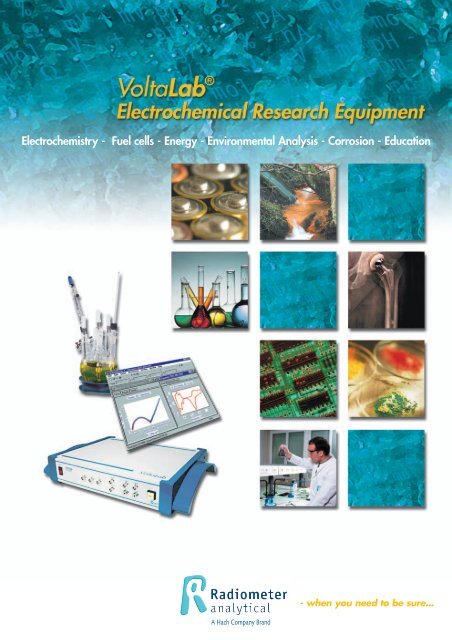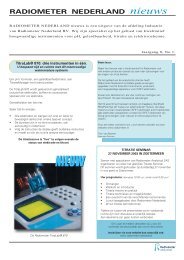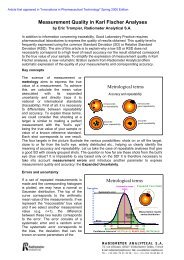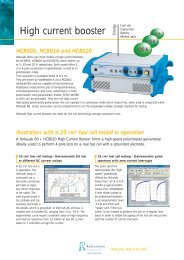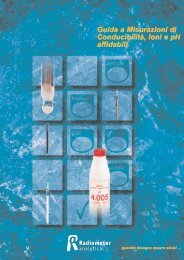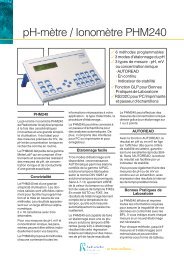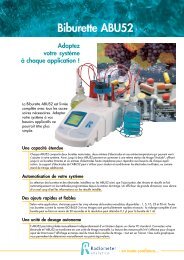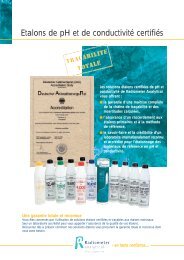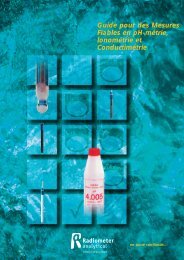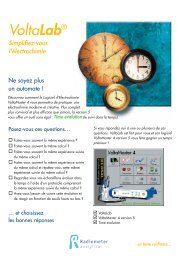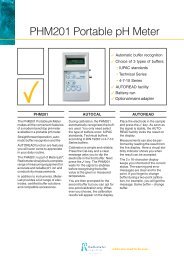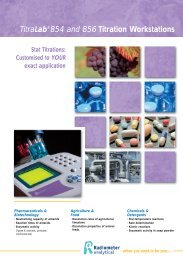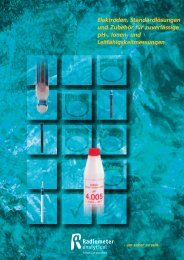Electrochemistry - Fuel cells - Radiometer Analytical
Electrochemistry - Fuel cells - Radiometer Analytical
Electrochemistry - Fuel cells - Radiometer Analytical
Create successful ePaper yourself
Turn your PDF publications into a flip-book with our unique Google optimized e-Paper software.
<strong>Electrochemistry</strong> - <strong>Fuel</strong> <strong>cells</strong> - Energy - Environmental Analysis - Corrosion - Education<br />
- when you need to be sure...
VoltaLab ®<br />
VoltaLab instrumentation is ideal for dc and ac<br />
electrochemical analysis applications in corrosion,<br />
pitting tests, battery testing, fuel <strong>cells</strong>, electroplating,<br />
electrocatalysis, nano materials, coatings and<br />
sensor development and includes a series of<br />
potentiostats and current/voltage boosters.<br />
Electrochemical Laboratories 3<br />
Specifications 7<br />
Connections 8<br />
Software 9<br />
Corrosion 16<br />
Voltammetry 17<br />
Impedance 18<br />
Polarography 19<br />
Universal Differential Pulse 20<br />
Battery testing 21<br />
Post-run processing 24<br />
Additional units 25<br />
Current Voltage Boosters 26<br />
Rotating Disc Electrode Stand 27<br />
Polarographic Stand 28<br />
Trace analysis 29<br />
Rotating Disc Electrodes 31<br />
Electrodes 33<br />
Cells 34<br />
Get a free poster for your lab<br />
www.voltalab.com
Simplicity<br />
Innovation<br />
VoltaLab offers outstanding software and highperformance<br />
hardware with innovative features<br />
such as the “Time evolution” concept. This exclusive<br />
function represents a veritable revolution in the<br />
world of electrochemistry.<br />
All-in-one concept<br />
The VoltaLab “All-in-one” concept is very simple to<br />
understand and even simpler to benefit from. One<br />
software and one “potentiostat” are all you need!<br />
You can run any type of electrochemical experiment.<br />
There is no need to install a specific card in<br />
your PC. Communication is compatible with<br />
USB/RS232C connectors.<br />
Full/Routine<br />
VoltaMaster 4 can be run in full or routine mode.<br />
In routine mode, access to programing is restricted,<br />
providing additional security.<br />
Exclusive functions<br />
The tools methods is what makes VoltaLab stand<br />
out from rival products. It allows you to drive your<br />
experiment by creating protocols which respond<br />
according to automatically calculated results such<br />
as the intensity of a peak or its position.<br />
Maximum efficiency<br />
Concentrate on your research. Forget about technical<br />
difficulties. VoltaLab offers the easiest to use<br />
and most versatile “All-in-one” potentiostats on the<br />
market. See how you can master your electrochemical<br />
interfaces with VoltaLab.<br />
Register at www.voltalab.com<br />
When you register to download VoltaMaster 4<br />
software, you will discover that the VoltaLab all-inone<br />
concept is the best solution for your experimental<br />
needs, whatever they may be.<br />
Customer support<br />
hotline@nalytical.com<br />
We asked VoltaLab users to tell us what would<br />
really help them save time. Then we added it to<br />
VoltaMaster 4 to offer the most complete electrochemical<br />
software on the market.<br />
2
Electrochemical Laboratories<br />
Controlled by VoltaMaster 4<br />
Every VoltaLab electrochemical laboratory consists<br />
of a potentiostat, VoltaMaster 4 software and a set<br />
of cables.<br />
Auto Peak Analysis<br />
“Time evolution”<br />
VoltaLab 21 VoltaLab 10 VoltaLab 40 VoltaLab 50 VoltaLab 80<br />
• • • • •<br />
• •<br />
Scan rate 0.01 V/s 0.5 V/s 20 V/s 20 V/s 20 V/s<br />
Best current resolution 100 pA 30 pA 30 pA 0.3 pA 0.3 pA<br />
EIS Maximum frequency 100 kHz 100 kHz/40 kHz 100 kHz/40 kHz<br />
EIS Modes<br />
Potentiostatic<br />
Potentiostatic<br />
Galvanostatic<br />
Recommended for Corrosion Education Development<br />
Quantitative<br />
analysis<br />
Potentiostatic<br />
Galvanostatic<br />
Fundamental<br />
research<br />
VoltaLab 21<br />
Self-contained system equipped with programmable<br />
controls on the front panel. Able to function both<br />
in floating and non-floating mode.<br />
VoltaLab 10<br />
All-in-one system which brings you a multitude of<br />
functions in a compact box at an unbeatable price.<br />
VoltaLab 40<br />
Dynamic system which combines outstanding performance<br />
and ease of use. A major breakthrough<br />
in the field of ohmic drop compensation with<br />
dynamic compensation controlled by impedance<br />
measurement.<br />
VoltaLab 50<br />
<strong>Analytical</strong> system which offers the convenience<br />
required for routine use of cyclic voltammetry in<br />
quantitative analysis.<br />
VoltaLab 80<br />
Universal system which enables you to develop and<br />
perform all current electrochemical experiments,<br />
even the most complex. Automatic processing and<br />
efficient peripheral management functions.<br />
See page 25 for additional units<br />
3
VoltaLab 21<br />
Economical Electrochemical Laboratory<br />
Manual<br />
Front panel<br />
Rolling menu settings<br />
Large LCD display<br />
VoltaLab 21 is a compact potentiostat/galvanostat<br />
with built-in signal generator that can be used as<br />
a stand-alone instrument when it is programmed<br />
through its front panel. In this manual mode, the<br />
potentiostat scan rate can be selected up to<br />
2.5 V/s. With VoltaMaster 4, the maximum scan<br />
rate is 10 mV/s. Ideal for corrosion studies,<br />
VoltaLab 21 records the polarisation resistance<br />
and the corrosion potential over very long periods.<br />
Pitting tests as well as coupled corrosion tests<br />
are available. VoltaLab 21 works either in floating<br />
or non-floating mode.<br />
PGP201<br />
Economical Potentiostat<br />
Voltammetry<br />
Maximum compliance voltage<br />
±20 V<br />
Ordering information<br />
Maximum current output<br />
±1 A<br />
VoltaLab 21 (230 V)<br />
A41A009<br />
Maximum polarisation voltage<br />
±4 V<br />
VoltaLab 21 (115 V)<br />
A41A010<br />
VoltaLab 50<br />
<strong>Analytical</strong><br />
Voltammetry<br />
Universal DP<br />
PST050<br />
<strong>Analytical</strong> Potentiostat<br />
<strong>Analytical</strong> Electrochemical Laboratory<br />
VoltaLab 50 is an analytical quantitative laboratory<br />
which automates and simplifies any type of electrochemical<br />
analysis using standard addition,<br />
standard calibration and calibration by addition.<br />
Everything is made easy and practical. For<br />
instance the spectrums can be automatically compared<br />
to reference spectrum in order to establish<br />
a “pass or fail“ protocol. User-selectable units<br />
and blank and dilution factor management are<br />
some of the fundamental features provided. Every<br />
DC technique can be set and run, including the<br />
extraordinarily powerful Universal Differential<br />
Pulse method.<br />
Ordering information<br />
Voltammetry<br />
Maximum compliance voltage<br />
±30 V<br />
VoltaLab 50 (230 V)<br />
R21V015<br />
Maximum current output<br />
±1 A<br />
VoltaLab 50 (115 V)<br />
R21V016<br />
Maximum polarisation voltage<br />
±15 V<br />
See page 7 and 8 for more technical data<br />
4
VoltaLab 10<br />
All-in-one Electrochemical Laboratory<br />
VoltaLab 10 is an all-in-one system which brings<br />
you a multitude of functions in a compact box at<br />
an unbeatable price. As it is the easiest to use<br />
“all-in-one” potentiostat on the market, it is the<br />
obvious choice for teaching or for beginners in<br />
electrochemistry. It offers Voltammetry and Electrochemical<br />
Impedance Spectroscopy.<br />
Education<br />
Simplicity<br />
Voltammetry<br />
Impedance<br />
EIS<br />
Voltammetry<br />
Maximum compliance voltage<br />
Maximum current output<br />
±30 V<br />
±1 A<br />
PGZ100<br />
All-in-one Potentiostat<br />
Maximum polarisation voltage<br />
±15 V<br />
Electrochemical Impedance<br />
Ordering information<br />
Max. frequency<br />
100 kHz<br />
VoltaLab 10 (230 V)<br />
R21V011<br />
Min. frequency<br />
1 mHz<br />
VoltaLab 10 (115 V)<br />
R21V012<br />
VoltaLab 40<br />
Complete<br />
Potentiostat<br />
Signal generator<br />
Digital acquisition<br />
EIS<br />
Dynamic Electrochemical Laboratory<br />
VoltaLab 40 is a dynamic system which combines<br />
outstanding performance and ease of use. It represents<br />
a major breakthrough in the field of ohmic<br />
drop compensation by offering dynamic compensation<br />
controlled by impedance measurement. It is<br />
the obvious choice for high-level researchers. As it<br />
is the easiest to use and most versatile “all-inone”<br />
potentiostat on the market, it is ideal for<br />
Electrochemical Impedance Spectroscopy combined<br />
with conventional methods such as Voltammetry.<br />
PGZ301<br />
Dynamic Potentiostat<br />
Voltammetry<br />
Maximum compliance voltage<br />
±30 V<br />
Maximum current output<br />
±1 A<br />
Maximum polarisation voltage<br />
±15 V<br />
Ordering information<br />
Electrochemical Impedance<br />
VoltaLab 40 (230 V)<br />
R21V007<br />
Max. frequency<br />
100 kHz<br />
VoltaLab 40 (115 V)<br />
R21V008<br />
Min. frequency<br />
1 mHz<br />
See page 7 and 8 for more technical data<br />
5
VoltaLab 80<br />
Universal Electrochemical Laboratory<br />
VoltaLab 80 is a universal instrument that will<br />
serve your imagination, making the use of delicate<br />
electrochemistry so simple and efficient that you<br />
will benefit from its potential straightaway.<br />
Everything is available from the simplest tutorial<br />
to the ultimate state-of-the-art methods, the<br />
“Universal Differential Pulse”. These universal<br />
methods exist either in recurrent mode (for battery<br />
testing) or over a potential ramp for analytical<br />
purposes. VoltaLab 80 is the most versatile potentiostat<br />
and software combination around.<br />
Universal<br />
Universal Pulse<br />
Dynamic EIS<br />
Voltammetry<br />
EIS<br />
Voltammetry<br />
Maximum compliance voltage<br />
Maximum current output<br />
Maximum polarisation voltage<br />
±30 V<br />
±1 A<br />
±15 V<br />
PGZ402<br />
Universal Potentiostat<br />
Electrochemical Impedance<br />
Ordering information<br />
Max. frequency<br />
Min. frequency<br />
100 kHz<br />
1 mHz<br />
VoltaLab 80 (230 V)<br />
VoltaLab 80 (115 V)<br />
R21V009<br />
R21V010<br />
Easy<br />
Two potentiostats* can<br />
be put together to make<br />
a bipotentiostat<br />
Bipotentiostat<br />
Combination of 2 potentiostats (see p. 25)<br />
You can obtain a 2 separate working electrode<br />
system immediately with VoltaLab. Simply combine<br />
two potentiostats to obtain a bipotentiostat. Two<br />
working electrodes, one counter electrode and one<br />
reference electrode. The ring and disc currents<br />
are saved in the same file.<br />
*Possible combinations<br />
PGZ402 + PGZ402<br />
PGZ402 + PGZ301<br />
PGZ402 + PGZ100<br />
PGZ402 + PST050<br />
Recommended:<br />
PGZ100 + PST050<br />
PGZ301 + PGZ100<br />
PGZ301 + PST050<br />
PGZ301 + PGZ301<br />
PGZ100 + PST050<br />
6
Hardware<br />
Electrical specifications<br />
VoltaLab 50<br />
VoltaLab 80<br />
VoltaLab 40<br />
VoltaLab 10<br />
VoltaLab 21<br />
Compliance voltage ±30 V* ±30 V* ±30 V* ±30 V* ±20 V<br />
Maximum current output ±1 A ±1 A** ±1 A ±1 A ±1 A<br />
Polarisation voltage ±15 V ±15 V ±15 V ±15 V ±4 V<br />
Slew rate 10000 KV/s 10000 KV/s 10000 KV/s 10000 KV/s 300 KV/s<br />
Rise time (100% signal) < 1µs < 1µs < 1µs < 1µs < 4 µs<br />
Bandwidth (-3dB) 800 kHz 800 kHz 800 kHz 800 kHz 200 kHz<br />
Current autoranging Yes Yes Yes Yes Yes<br />
Potential autoranging Yes Yes Yes Yes Yes<br />
Measurements (A/D converters) 16 bits 16 bits 16 bits 16 bits 20000 points<br />
Applied DC potential<br />
Ranges ±4, 8, 15 V ±4, 8, 15 V ±4, 8, 15 V ±4, 8, 15 V ±4 V<br />
Best resolution 125 µV 125 µV 125 µV 125 µV 125 µV<br />
Accuracy (% of range) ±0.2% ±0.2% ±0.2% ±0.2% ±0.2%<br />
Measured potential<br />
Ranges ±2, 4, 8, 15 V ±2, 4, 8, 15 V ±2, 4, 8, 15 V ±2, 4, 8, 15 V ±8 V<br />
Best resolution 60 µV 60 µV 60 µV 60 µV 1 mV<br />
Resolution (% of range) 0.003% 0.003% 0.003% 0.003% 0.0125%<br />
Accuracy (% of range) ±0.2% ±0.2% ±0.2% ±0.2% ±0.2%<br />
Analogue output Yes Yes Yes Yes Yes<br />
DC offset and gain (10 & 100) Yes Yes Yes for EIS Yes for EIS No<br />
* Can be increased to 100 V with the HVB100 High Voltage Booster<br />
** Can be increased to 20 A with the HCB020 Current Booster<br />
*** 1% with 100 nA and 10 nA range<br />
Measured current<br />
Highest range 1 A (9 ranges) 1 A (9 ranges) 1 A (7 ranges) 1 A (7 ranges) 1 A (7 ranges)<br />
Lowest range 10 nA (with gain) 10 nA (with gain) 1 µA 1 µA 1 µA<br />
Best resolution 300 fA (with gain) 300 fA (with gain) 30 pA 30 pA 100 pA<br />
Resolution (% of range) 0.003% 0.003% 0.003% 0.003% 0.01%<br />
Accuracy (% of range) ±0.2%*** ±0.2%*** ±0.2%*** ±0.2%*** ±0.2%***<br />
DC offset and gain (10 & 100) Yes Yes Yes for EIS Yes for EIS No<br />
Analogue output Yes Yes Yes Yes Yes<br />
Automatic filters Yes Yes Yes Yes Yes<br />
Manual filters 7 filters 7 filters 7 filters 7 filters 5 filters<br />
Anti-oscillation filter Yes Yes Yes Yes No<br />
Scanning performances<br />
Measurement period 0.5 ms 0.5 ms 0.5 ms 20 ms 1 s<br />
Max. scan rate (10 mV steps) 20 V/s 20 V/s 20 V/s 500 mV/s 10 mV/s<br />
Ohmic Drop Compensation<br />
Dynamic Impedance Driven Yes Yes Yes No<br />
Static manual & Static auto Yes Yes Yes Yes<br />
Feedback manual & Feedback auto Yes Yes Yes No<br />
Electrochemical Impedance<br />
Max. frequency 100 kHz 100 kHz 100 kHz<br />
Min. frequency 1 mHz 1 mHz 1 mHz<br />
Frequencies/decade 5, 10, 20 5, 10, 20 5, 10, 20<br />
Sine wave amplitude 1 mV to 1 V 1 mV to 1 V 1 mV to 1 V<br />
Ranges for AC potential 50 & 1000 mV 50 & 1000 mV 50 & 1000 mV<br />
Resolution 12.5 & 250 µV 12.5 & 250 µV 12.5 & 250 µV<br />
Accuracy (% of range) ±0.5% ±0.5% ±0.5%<br />
Current autoranging Yes Yes Yes<br />
Delay before integration Yes Yes Yes<br />
EIS distortion for module 1% ±(0.02%/kHz) 1% ±(0.02%/kHz) 1% ±(0.02%/kHz)<br />
EIS distortion for phase shift 1°±(0.02°/kHz) 1°±(0.02°/kHz) 1% ±(0.02%/kHz)<br />
7
Connections<br />
VoltaLab 50<br />
VoltaLab 80<br />
VoltaLab 40<br />
VoltaLab 10<br />
VoltaLab 21<br />
Rear panel connections<br />
Functional ground to connect a Faraday cage Banana Banana<br />
Serial port to connect a Pentium based PC RS232C SUB-D9 male<br />
Cell connections<br />
REF (Reference Electrode, RE) BNC BNC<br />
Input impedance 10¹² Ohm 10¹² Ohm<br />
Capacitance
Software<br />
VoltaMaster 4<br />
This superb software is the cornerstone of your<br />
VoltaLab Electrochemical Laboratory.<br />
Designed by electrochemists<br />
The only way to satisfy users’ requirements is to<br />
listen to what they have to say. That’s our policy.<br />
To tell the truth it is you, the electrochemists, who<br />
have designed the VoltaLab family of instruments.<br />
Simple to use<br />
Programming, archiving and data handling could<br />
not be easier. Whether you are an absolute beginner<br />
or an expert, it takes five minutes to feel confident<br />
with VoltaLab thanks to intuitive multitasking<br />
software.<br />
VoltaMaster 4 minimum PC<br />
requirements<br />
• 64 MB of RAM, 50% free space<br />
• Microsoft Windows ® 95, Windows ® 98,<br />
Windows ® NT 4.0, Windows 2000 Professional<br />
edition, Windows Millenium or Windows XP<br />
• Microsoft Excel 97 for users working with the<br />
VM4RESULTS.XLS calculation results file<br />
• Pentium II 400 MHz microprocessor<br />
• CD-ROM drive<br />
• RS232C serial interface - PC with USB port only:<br />
use a separate USB to RS232C converter box<br />
• Printer connection<br />
• VGA colour graphics card (min. screen resolution<br />
600x800 on the "Desktop")<br />
• Windows compatible mouse<br />
• 2 GB hard disk, 50% free space<br />
Free upgrade<br />
Visit www.voltalab.com and register your VoltaLab<br />
system to benefit from your free VoltaMaster 4 latest<br />
version right now!<br />
9
34 acquisition methods<br />
to measure experimental data<br />
VoltaLab 21<br />
VoltaLab 10<br />
VoltaLab 40<br />
VoltaLab 50<br />
VoltaLab 80<br />
Visual methods<br />
Visual EIS<br />
Visual IFV<br />
• Voltammetry<br />
• Electrochemical Impedance<br />
• <strong>Analytical</strong> pulses<br />
• Corrosion<br />
• Battery/Energy<br />
• Material testing<br />
Electrochemical methods<br />
Open Circuit Potential<br />
Pot. Tutorial Cyclic Voltammetry<br />
Pot. Tutorial Chrono Amperometry<br />
Pot. Interactive Cyclic Voltammetry<br />
Pot. Linear Voltammetry<br />
Gal. Linear Voltammetry<br />
Pot. Cyclic Voltammetry<br />
Gal. Cyclic Voltammetry<br />
Pot. Step by step Cyclic Voltammetry<br />
Gal. Logarithmic Cyclic Voltammetry<br />
Pot. Low Current Cyclic Voltammetry<br />
Tast Polarography<br />
Pot. Expert EIS<br />
Pot. Tutorial EIS (Impedance)<br />
Pot. Dynamic EIS (Impedance)<br />
Pot. Fixed Freq. EIS (Capacitance)<br />
Gal. Tutorial EIS (Impedance)<br />
Chrono Amperometry<br />
Chrono Coulometry<br />
Chrono Potentiometry<br />
Gal.Coulometry<br />
Low Current Chrono Amperometry<br />
Pot. Universal Differential Pulse Voltammetry<br />
Gal. Universal Differential Pulse Voltammetry<br />
Pot. Recurrent Differential Pulse Voltammetry<br />
Gal. Recurrent Differential Pulse Voltammetry<br />
Pot. Square Wave Voltammetry<br />
Gal. Square Wave Voltammetry<br />
Pitting corrosion<br />
General corrosion (Rp)<br />
Coupled corrosion (Evans)<br />
Polarisation for corrosion (Tafel)<br />
10
23 tool methods<br />
to organise protocols and calculate results<br />
VoltaLab 21<br />
VoltaLab 10<br />
VoltaLab 40<br />
VoltaLab 50<br />
VoltaLab 80<br />
Run External Utility<br />
Auto. Peak Analysis<br />
Auto. R1R2C Fitting<br />
• Automatic Calculation<br />
• Automatic Report<br />
• External Utility Control<br />
• Dialogue boxes<br />
• Time Evolution<br />
• Data Quality Management<br />
• Loops<br />
Auto Linear Extraction<br />
Vg IN On/Off<br />
Auto. Traject<br />
Message<br />
Relocate potentials<br />
If/if not method<br />
Jump to method<br />
Last point<br />
Current efficiency<br />
Print report<br />
Yes or No?<br />
Save curve as<br />
Sort out by potential<br />
Results from Results: Linear combination of results<br />
Time evolution<br />
Standard addition<br />
Standard calibration<br />
Calibration by addition<br />
Calibration CV ST<br />
Sample CV ST<br />
Virtual mode<br />
11
“Time Evolution”<br />
Exclusive and outstanding<br />
Time evolution lets you record the calculated<br />
results as a function of time. This method takes<br />
place within a loop: measurement, calculation,<br />
Time evolution, jump to measurement… as many<br />
times as you need. Investigating material ageing<br />
or new sensor performance has never been so<br />
easy.<br />
3-D plot<br />
Imagine that in addition to your experimental<br />
voltammetry you will get one calculated results<br />
curve plus a file containing all the curves used for<br />
the calculations. You can display a representation<br />
in 3-D.<br />
Protocol organisation<br />
Time evolution not only displays these values; it<br />
also compares the last result with a set high and<br />
low value. This means action can be taken<br />
straightaway, for example automatically adding<br />
reagent from a burette.<br />
Data Quality Management<br />
This calculated curve is plotted on the screen during<br />
acquisition. The last value, date and time of its<br />
acquisition and countdown until the next measurement<br />
are all displayed so you know your exact<br />
progress. You can adjust the scale manually for a<br />
clearer overview.<br />
The value is expressed in the unit and with the<br />
name selected in the calculation method.<br />
12
<strong>Electrochemistry</strong> with Time Evolution:<br />
Battery discharge followed by EIS<br />
• Galvanic Tutorial EIS<br />
• Auto R1R2C<br />
• Time Evolution<br />
EIS spectrum<br />
The battery is discharged at constant<br />
current. Galvanostatic impedance is<br />
performed at regular intervals. The R2<br />
value is plotted against time with "Time<br />
Evolution".<br />
Routine analysis with polarography<br />
• Run External Utility<br />
• Chrono Amperometry<br />
• Pot. Universal DP<br />
• Auto Linear Extraction<br />
• Standard Calibration<br />
• Time Evolution<br />
Universal Differential Pulse<br />
Anodic stripping with Universal Differential<br />
Pulse. Nitrogen bubbling, stirring and<br />
mercury drop renewal are all automated.<br />
The quantitative result can be calculated<br />
from the peak height, the peak position or<br />
the area between two potential limits.<br />
Monitoring plating bath efficiency<br />
• Chrono Potentiometry<br />
• Pot. Coulometry<br />
• Current Efficiency<br />
• Time Evolution<br />
An aliquot taken from the actual production<br />
bath constitutes the sample. Constant<br />
potential deposition is followed by potentiodynamic<br />
stripping. The ratio between the<br />
deposition charge and the stripping charge<br />
measures the efficiency of the bath. Alarm<br />
thresholds can be set.<br />
Chrono potentiometry<br />
Pitting tests<br />
• Pitting<br />
• Auto Traject<br />
• Last Point (pitting)<br />
• Time Evolution (pitting)<br />
• Time Evolution<br />
(Repassivation)<br />
Pitting test (voltammetry)<br />
The sample is anodically polarised until<br />
pitting starts (current level). Then the potential<br />
is scanned back cathodically in order to<br />
determine the repassivation potential<br />
(current level).<br />
13
a new world of expertise<br />
Auto R1R2C Fitting<br />
Circular regression between two<br />
predefined frequency limits.<br />
The electroactive surface is taken into<br />
account in the calculation. The same experimental<br />
file can be used by several calculation<br />
methods and their respective "Time<br />
Evolution" methods so you can follow R1,<br />
R2 and C for each semicircle.<br />
It is also possible to follow the modulus or<br />
the phase at a given frequency.<br />
Standard Calibration<br />
Interpolation through a calibration<br />
curve.<br />
Quantitative calculation is provided either<br />
by standard addition or by calibration. In<br />
calibration mode, linear as well as logarithmic<br />
or exponential regression modes are<br />
available with blank subtraction if needed.<br />
Several species can be followed as several<br />
calculation methods and their respective<br />
"Time Evolution" methods can use the same<br />
experimental file.<br />
Current Efficiency<br />
Using a pair of experimental curves, a<br />
number of different indices featuring the<br />
respective anodic and cathodic charges can<br />
be calculated. Another useful function allows<br />
experimental curves obtained each cycle to<br />
be compared with a reference curve already<br />
archived.<br />
Ratio between deposition and stripping<br />
charges.<br />
Last Point<br />
The last potential of the anodic polarisation<br />
corresponds to the potential at which the set<br />
current limit is reached. In addition, by<br />
choosing Auto Peak Analysis in combination<br />
with Time Evolution, you can follow the<br />
maximum current reached during the test.<br />
Selection of the last point co-ordinate in<br />
anodic polarisation (potential).<br />
14
VoltaMaster 4 step by step<br />
You create a sequence to organise measurements.<br />
This sequence includes calculations.<br />
Real time plot during aquisition.<br />
Automatic print out of calculations.<br />
Display of results.<br />
Printing of results.<br />
15
Corrosion<br />
with VoltaLab 21/10/40/50/80<br />
Pitting test<br />
The “pitting potential” of stainless steel corresponds<br />
to the potential at which the current starts to<br />
increase on the anodic scan and the “repassivation<br />
potential” corresponds to the potential at which<br />
the current becomes negligible on the reverse<br />
(cathodic) scan. A “repassivation potential” close<br />
to the “pitting potential” indicates that the sample<br />
is capable of reprotecting itself easily after pitting.<br />
Corrosion tests<br />
Corrosion tests typically consist of a Polarisation<br />
curve, Tafel analysis, Pitting test, Polarisation<br />
Resistance or Evans tests.<br />
Polarisation curve<br />
It is simple to obtain a polarisation curve according<br />
to ASTM G3 and G5, for instance. Both Tafel and<br />
Stern calculations can be performed to achieve<br />
corrosion parameter determination.<br />
Polarisation resistance test<br />
The Rp polarisation resistance helps to evaluate<br />
the anti-corroding strength of a corrosion inhibitor<br />
or to study a uniform corrosion process. The Rp<br />
variations versus time are automatically recorded.<br />
Each experimental point (Rp value and rest potential)<br />
is obtained from one individual voltammetry<br />
which is automatically processed with selectable<br />
algorithms (Linear, Stern, GFC etc.). Individual<br />
voltammetries are also saved. Between two Rp<br />
determinations, the system is left at rest (the circuit<br />
is open) for a time delay set by the user.<br />
Tafel analysis<br />
The corrosion current density expressed in loss of<br />
metal thickness per year is determined from the<br />
Tafel equation. The thermodynamic ba and bc<br />
parameters of the Butler Volmer equation are also<br />
obtained.<br />
2nd Stern analysis<br />
A parabolic regression determines the Rp as the<br />
slope of the tangent of the voltammetric curve at<br />
the zero-current potential.<br />
Evans test<br />
Coupled corrosion is also called bimetallic corrosion<br />
or galvanic corrosion. It occurs when two different<br />
materials subject to corrosion are in contact with<br />
each other and with the same solution. The less<br />
noble material suffers from corrosion, as predicted<br />
by the thermodynamic potentials of these materials.<br />
Evans experiments determine the corrosion current<br />
which is expected to take place at “rest” potential<br />
taking into account the areas. A variation of the<br />
relative surface area can be simulated in post-run<br />
processing.<br />
16
Voltammetry<br />
with VoltaLab 10/21/40/50/80<br />
Be interactive<br />
While running an interactive cyclic voltammetry,<br />
you can modify the scan rate and/or the potential<br />
settings and/or reverse the sweep direction and/or<br />
hold the potential for as long as you wish. You are<br />
in control!<br />
Interactive CV<br />
The Interactive Cyclic Voltammetry method replaces<br />
the need to use the front panel of the analogue<br />
potentiostat with the additional advantage of a<br />
digital function as results are saved as files.<br />
Interactivity is available up to 300 mV/s.<br />
You operate a CV interactive as if you were using<br />
an analogue instrument. You can change parameters<br />
and also clear the memory (which corresponds<br />
to a “new” sheet if we compare it with a<br />
chart recorder). It could not be more convenient.<br />
Benefit fully from interactivity<br />
Imagine that you are running a voltammetry. You<br />
observe a peak and want to start a chronocoulometry<br />
immediately and at this exact peak<br />
potential. It is child’s play with VoltaLab since relative<br />
electrochemistry is combined with interactivity!<br />
Relative electrochemistry<br />
The Pot. Linear Voltammetry offers a very convenient<br />
specification: you can quote the initial potential<br />
versus OCP and the final potential versus REF.<br />
Then you can polarise the electrode starting from<br />
this potential and finish recording your experiment.<br />
The benefit is that the potential is gradually driven<br />
from OCP towards the starting potential of the CV.<br />
Real-time display<br />
Your instrument permanently displays and records<br />
the current density (i), the working electrode<br />
potential (E), the total charge (Q), the synchronised<br />
additional channel input (A/D IN) and the time (t)<br />
elapsed on the run bar. The experimental curve is<br />
also plotted in real time. Even when you decide to<br />
“Hold” the potential, the data are saved. There is<br />
no maximum time or memory size limit! At the<br />
end of the experiment, you can extract the significant<br />
part of the experimental curve and save it as<br />
a separate file.<br />
CV interactive control panel<br />
Hold/Continue holds the potential/<br />
continues to scan the potential<br />
Start<br />
starts the active sequence<br />
Reverse<br />
reverses the scan direction<br />
Modify<br />
modifies the potential set-points, the scan<br />
rate, the number of cycles and clears the page<br />
Next<br />
skips to the next method within the sequence<br />
Stop<br />
stops the experiment and opens the circuit<br />
17
Impedance<br />
with VoltaLab 10/40/80<br />
Electrochemical Impedance<br />
Any type of Potentiostatic or Galvanostatic<br />
Electrochemical Impedance Spectroscopy experiment<br />
can be performed.<br />
EIS analysis<br />
Automatic R1R2C equivalent circuitry fitting is<br />
provided with a circular regression. The R1R2C<br />
conventional model for a simple electrochemical<br />
process is widely used to compare different samples<br />
or processes. EIS files can be transferred to<br />
Z-View for future analysis.<br />
Expert EIS<br />
Optimise your acquisition by taking advantage of<br />
current autoranging, the delay before integration<br />
and the easy definition of sub-scans with individual<br />
settings.<br />
Real-time display<br />
Nyquist (-Zimaginary versus Zreal) or Bode<br />
(modulus and phase shift versus logarithm of frequency)<br />
with Dynamic EIS method and (Zreal, -<br />
Zimaginary) versus potential during a potential<br />
scan at fixed frequency (Mott-Schottky type).<br />
Potentiostatic Impedance<br />
For kinetics, dynamic EIS (Impedance) being the<br />
fastest mode.<br />
Galvanostatic Impedance<br />
For corrosion and battery testing.<br />
Mott-Schottky (Capacitance)<br />
The Pot. Fixed Freq. EIS (Capacitance) method<br />
provides information about charge-transfer and<br />
adsorption mechanisms. The experimental file<br />
includes impedance data and the result of capacitance<br />
calculation plus DC potential and DC current.<br />
The voltammetry is recorded simultaneously along<br />
with the "Mott-Schottky" diagram.<br />
EIS programming is made easy for<br />
Frequency scan<br />
Frequency scan<br />
Potential scan<br />
Frequency scans<br />
Frequency scans<br />
Frequency scans<br />
Frequency scans<br />
at a single DC potential.<br />
at a single DC current.<br />
at fixed frequency (Mott-Schottky experiment).<br />
at specified time intervals at a single DC potential or current.<br />
at different DC potentials from initial to final in preset potential steps.<br />
at different DC currents at different preset currents.<br />
at specified time intervals at OCP (in combination with OCP method)<br />
at a single DC potential or current.<br />
18
Polarography<br />
With VoltaLab 50/80<br />
Calculations<br />
Each element is independently analysed.<br />
Smoothing and blank subtraction are available.<br />
Post-run processing<br />
You may wish to validate your choices step by<br />
step. Use “Differential Extraction” on the “raw<br />
data” curves to evaluate how you can improve the<br />
acquisition by adjusting the sampling window. Use<br />
“Subtraction/Addition” to remove the experimental<br />
blank from your sample curve. Use “Peak analysis”<br />
to examine your peak signals and adjust the settings<br />
used for quantitative analysis.<br />
Square Wave Voltammetry<br />
From Square Wave Voltammetry to Triple Normal<br />
Pulse Differential Voltammetry - every multipulse<br />
signal used in analytical electrochemistry can be<br />
programmed with VoltaLab.<br />
Printout<br />
Date, time, sample identification, operator and<br />
supervisor names, regression factor and file identification<br />
for traceability purposes are printed in<br />
addition to the value itself.<br />
Real-time plot<br />
Run your experiment and observe the real-time<br />
display of the differential current. Interactivity<br />
means you can jump to the next method or stop it<br />
if necessary.<br />
Experiment and calculation settings<br />
Create a sequence to control the stand, perform<br />
the acquisition, automatically examine the peaks<br />
and print the results.<br />
Database<br />
When a new quantitative result is calculated, a<br />
VM4RESULTS.xls file is created/modified.<br />
VoltaMaster 4 saves the result in real mode<br />
(VoltaLab 50 and VoltaLab 80 only) and in virtual<br />
mode (every system). Anyone can review the<br />
behaviour of the data without entering<br />
VoltaMaster 4. Filters to sort the data from the<br />
database and graphs on additional pages can be<br />
requested within the VM4RESULTS.xls file.<br />
19
Universal Differential Pulse<br />
with VoltaLab 50/80<br />
Universal Differential Pulse<br />
It is so simple to prepare a universal multipulse<br />
experiment with the Pot. Universal Differential<br />
Pulse method that what you get is - amazingly -<br />
what you want!<br />
Real-time plot<br />
Run your experiment and observe the real-time<br />
display of the differential measurement versus<br />
potential or time. Intervene in order to jump to the<br />
next method or stop if necessary. If you refer to<br />
the graphic folder of the settings, the differential<br />
current measurement is taken between positions<br />
represented by the red inverted triangles and<br />
quoted versus the potential imposed at the position<br />
shown by the blue triangle.<br />
Settings<br />
Define a Ramp, add a multipulse signal with 8<br />
levels on top and adjust the value and duration of<br />
each pulse individually. Click on Graphic to check<br />
the overall shape of the imposed signal. Universal<br />
Differential Pulse can be added in the sequence<br />
with any Method available, regulation can be<br />
maintained between methods with no gap! If in<br />
doubt, consult the Help file.<br />
Post-run processing<br />
In addition to the differential file, a raw data file<br />
records the current during the whole experiment<br />
with a sampling rate equal to the acquisition<br />
period time, down to 500 µs. Post-run processing<br />
enables the user to recalculate any differential<br />
curve from the raw data, adjusting the “sampling<br />
window” and to extract any “Linear voltammetry”<br />
from it using the Linear extraction tool. Display<br />
them as you wish, extract the interesting parts,<br />
overlay curves, export them, calculate results.<br />
Universal Differential Pulse<br />
The principle is to define a combination of up to 8 levels of imposed potential (or current)<br />
versus time. Each step can last 255 times the acquisition period time (sampling rate). This<br />
sampling rate can be selected from 0.5 ms to 999s. RECURRENT, Linear SCAN and<br />
NORMAL modes are available. In normal mode, the applied set point is reset to an initial<br />
level to “regenerate” the interface between each pulse.<br />
20
Battery testing<br />
with VoltaLab 80/50<br />
Universal Differential Pulse<br />
It is so simple to prepare a universal multipulse<br />
experiment with the Pot. Universal Differential<br />
Pulses method that what you get is - amazingly -<br />
what you want!<br />
Gal. Recurrent Differential Pulse<br />
To increase the performance of a battery, it is possible<br />
to charge it under various conditions.<br />
A multilevel pulse galvanostatic signal optimises<br />
the charge. The Galvanostatic Recurrent Differential<br />
Pulse method is ideal for preparing experiments<br />
like this and combining them with galvanostatic<br />
experiments without opening the circuitry.<br />
Real-time plot<br />
Run your experiment and observe the real-time<br />
potential display. Intervene to jump to the next<br />
method or stop it if necessary.<br />
Settings<br />
Define a maximum duration, set a potential limit<br />
and define a resolution time (equal to the shortest<br />
pulse you want to use) then build your multipulse<br />
signal with 8 levels and adjust the height and<br />
duration of each pulse individually. Click on the<br />
Graphic to verify the overall shape of the imposed<br />
signal. This method will charge the battery.<br />
Sequence<br />
You can create a sequence of alternate charging<br />
and discharging. In addition, you may want to<br />
insert electrochemical impedance measurement at<br />
rest after each cycle. Nothing could be more simple.<br />
Post-run processing<br />
Post-run processing enables you to “Append” all<br />
the curves and filter them in order to reduce the<br />
number of points to a convenient number without<br />
losing information. This can be automated during<br />
the experiment.<br />
21
DIDODC<br />
with VoltaLab 40/80/50<br />
Dynamic Impedance Driven Ohmic<br />
Drop Compensation<br />
This unique feature is a selectable option within<br />
the relevant methods.<br />
Simplicity<br />
Prepare your Cyclic Voltammetry and select<br />
“Ohmic Drop compensation”. It is that simple.<br />
What you get is - amazingly - what you want!<br />
Resistance monitoring<br />
The cell resistance is measured, recorded and<br />
compensated step by step during the experiment.<br />
The variations in this resistance can form a new<br />
investigation method.<br />
With or without compensation?<br />
Many theories, especially in cyclic voltammetry,<br />
are only valid if the potential is driven linearly as<br />
a time function at the interface itself.<br />
Experimentally, the linearity is often not respected<br />
because of the Ohmic Drop and, as a consequence,<br />
relevant potentials are shifted. With<br />
Ohmic Drop compensation, the peaks are sharper.<br />
Dynamic Impedance Driven ODC<br />
is an innovative feature designed to compensate<br />
Ohmic Drop. During the experiment, the “cell-electrolyte”<br />
resistance is measured step by step by<br />
impedance. The OD is then calculated and the set<br />
potential for the next step automatically adjusted.<br />
The imposed potential compensates this OD. This<br />
active compensation is provided through algorithmic<br />
regulation without any risk of oscillations. Last<br />
but not least, this is a software-selectable option<br />
effective up to 100 mV/s with autoranging for<br />
current measurement.<br />
Static ODC<br />
is based on an impedance measurement with an<br />
active compensation provided through algorithmic<br />
regulation. It is effective up to 1000 mV/s with<br />
autoranging for current measurement.<br />
Feedback ODC<br />
is available up to 20 V/s with automatic determination<br />
of the cell resistance by impedance.<br />
Mathematical ODC<br />
“Resistance subtraction” in post-run processing is<br />
also provided for DC measurements.<br />
How ODC works<br />
The Ohmic Drop is the product of the current which flows<br />
through the resistance of the electrolyte between the reference<br />
electrode and the electrochemically active interface<br />
of the working electrode. Due to the ohmic drop phenomenon,<br />
the potential at the interface is slightly different from<br />
the expected potential. Interface potential = (WORK-REF)<br />
potential - Ohmic Drop. The maximum resistance which<br />
can be compensated depends on the total current which<br />
flows through the electrochemical cell, on the polarisation<br />
voltage and on the compliance voltage.<br />
22
VoltaMaster 4<br />
Electrochemical Software<br />
Help<br />
An illustrated Help section contains recommendations<br />
on how to prepare, run and examine experiments.<br />
A comprehensive set of demonstration<br />
curves and experimental method sequences is also<br />
available.<br />
Monitor bar<br />
The Monitor bar gives useful information<br />
between experiments. It displays the working electrode<br />
potential (in mV), plus the potentiostat status.<br />
As soon as an experiment starts, the Monitor bar<br />
is replaced by the Run bar<br />
All-in-one<br />
A single software to perform, analyse and document<br />
experiments in order to prepare your publications.<br />
RCB200<br />
The RCB200 Resistor<br />
Capacitor Box will help<br />
you become familiar with<br />
VoltaLab Electrochemical<br />
Laboratories and check their<br />
main technical specifications with “ready-to-use”<br />
sequences available in VoltaMaster 4.<br />
Interactive real-time display<br />
Real-time display is available at all times, even at<br />
maximum sampling rate. You can skip to the next<br />
method within the sequence, stop the experiment<br />
or modify any interactive setting.<br />
Cell setup<br />
Use the cell setup to define your reference electrode<br />
and parameters useful for autocalculations, for<br />
instance in corrosion.<br />
Multitasking<br />
You can drive up to 8 VoltaLab potentiostats<br />
simultaneously from a single PC. You can examine<br />
files which have already been acquired while the<br />
experiment is still running.<br />
23
Post-run processing<br />
Curve operation<br />
X Y1 Y2 representation - Zoom - Overlay/Remove<br />
- Linear extraction - Differential extraction -<br />
Potential reset/offset - Current reset/offset -<br />
Charge reset/offset - Time reset/offset - Curve<br />
addition/subtraction - Append - Export (to Excel 97<br />
or higher) - Smoothing - Cursor - Title - Legend<br />
Type bar<br />
The type bar is the most versatile tool for representing<br />
your experimental curves. All parameters<br />
can be displayed.<br />
Post-run<br />
Everything is ready for you to document your<br />
experiment and prepare your report.<br />
Calculation routines<br />
Peak analysis - Integration - Tafel analysis - Linear<br />
regression - Circular regression - R1R2C fitting for<br />
EIS - Stern analysis - Evans analysis - Coulometric<br />
dissolution - Resistance subtraction - Standard<br />
Addition - Standard Calibration - Sort by potential.<br />
Export facility<br />
This exports the curve as displayed in Excel in<br />
order to help you to transfer experimental data to<br />
other software. You can, for instance, transfer log<br />
(current) versus sqrt (time).<br />
Result database<br />
Every quantitative result is automatically recorded<br />
in an Excel database for optimum connection to<br />
LIMS systems.<br />
Curve save as<br />
To give your most important files explicit names,<br />
independent from the sequence name.<br />
“Results” folder<br />
Each curve has a “Results” folder where you can<br />
attach comments and save the results of the calculations<br />
performed with the analysis tool. This information<br />
is saved and can be printed with the curve.<br />
Whenever you open a curve, the information you<br />
need is there.<br />
Experimental curves in ASCII<br />
They feature Potential, Current, Time, Resistance,<br />
Auxiliary, A/D IN, Frequency, Module, Phase,<br />
Zreal, -Zimaginary and Capacitance, depending<br />
on method settings. Any data from one file can be<br />
displayed (as Y1 or Y2) versus any other data<br />
from this file (as X) with mathematical functions to<br />
process X, Y1 and Y2 such as log, sqrt, inv.<br />
“Intelligent filter”<br />
Linear Extraction reduces your file size without losing<br />
any information. You can also apply offsets to<br />
quote your potentials versus SHE, for example.<br />
And it can be automated!<br />
24
Additional units<br />
VoltaLab 10<br />
VoltaLab 40<br />
VoltaLab 50<br />
VoltaLab 80<br />
VoltaLab 21<br />
Additional units<br />
<strong>Analytical</strong> rotating disc stand<br />
To perform quantitative analysis with stripping cyclic voltammetry on a rotating<br />
disc electrode, the RDS010 is the obvious choice.<br />
Voltage booster<br />
The HVB100 High Voltage Booster boosts your VoltaLab system compliance voltage<br />
up to ±100 V. Useful in organic electrochemistry or when a very large ohmic<br />
drop needs to be compensated.<br />
Current booster<br />
HCB020: the ultimate choice for fuel cell investigations with galvanostatic expert<br />
EIS available under 20 A and current interrupt management.<br />
Mercury drop electrode stand<br />
To perform stripping analysis and pulse polarography, the MDE150 Polarographic<br />
Stand can be directly driven from VoltaMaster 4.<br />
Potentiostats X,Y,Vg<br />
VoltaLab 80 allows you to operate any of your potentiostats featuring potential and<br />
current analogue output plus signal generator input with the “X,Y,Vg” instrument<br />
setup selection.<br />
External unit<br />
Any type of external unit controlled by a RS232C (e.g. microbalance, burette,<br />
spectrometer) can be driven from VoltaMaster 4.<br />
Quartz microbalance<br />
We recommend the PM-710 from Maxtek with its DI-10 DAC interface.<br />
Combinations<br />
Bipotentiostat<br />
To perform Ring Disc Rotating Electrode measurements, for example, use two<br />
VoltaLab systems simultaneously. The WE1 and the WE2 currents are saved in the<br />
same file thanks to the A/D IN channel for easy interpretation of your results.<br />
Multipotentiostat<br />
You can drive up to 8 potentiostats independently<br />
and simultaneously from one PC (USB/RS232<br />
required) with VoltaMaster 4.<br />
External signal generator<br />
An external analogue signal generator can be used<br />
for instance to impose high scan rates or a special<br />
wave form.<br />
Recommended<br />
Possible<br />
25
High voltage booster<br />
Organics<br />
High compliance voltage<br />
for highly resistive media<br />
The HVB100 boosts your compliance voltage up<br />
to ±100 V. Connect the HVB100 to your PGZxxx<br />
or PST050 Potentiostat and declare it in the<br />
VoltaMaster 4 setup. Every method is still available.<br />
This additional unit is useful in organic electrochemistry<br />
or when a very large ohmic drop needs<br />
to be compensated. Compatible with VoltaLab 10,<br />
VoltaLab 40, VoltaLab 50 and VoltaLab 80.<br />
HVB100<br />
High Voltage Booster<br />
Ordering information<br />
HVB100 (230 V)<br />
HVB100 (115 V)<br />
R21V013<br />
R21V014<br />
High current boosters<br />
Energy<br />
<strong>Fuel</strong> cell<br />
Capacitors<br />
Battery<br />
Molten salt<br />
HCB020<br />
High Current Booster<br />
Ordering information<br />
HCB005 (230 V)<br />
HCB005 (115 V)<br />
HCB010 (230 V)<br />
HCB010 (115 V)<br />
HCB020 (230 V)<br />
HCB020 (115 V)<br />
R21V031<br />
R21V032<br />
R21V029<br />
R21V030<br />
R21V027<br />
R21V028<br />
VoltaLab offers you three models, the HCB005,<br />
HCB010 and HCB020 which deliver up to 5, 10<br />
and 20 A respectively. Each model offers 2, 3 or<br />
4-pole connections in galvanostatic as well as in<br />
potentiometric mode. Time resolution is available<br />
down to 0.5 ms. They are driven by a PGZ402<br />
(VoltaLab 80) and capable of Electrochemical<br />
Impedance measurement. Either WORK or AUX<br />
can be grounded. They are ideal for fuel cell and<br />
energy storage component tests.<br />
26
Rotating Disc Electrode Stand<br />
The RDS010 <strong>Analytical</strong> Rotating Disc Stand stays<br />
safely in place whenever you have to handle your<br />
sample. It accommodates a Rotating Disc<br />
Electrode and solid electrodes very easily in its 4<br />
holes (14.5/23 sleeves). The rotation speed of the<br />
RDE is driven from VoltaMaster 4 with VoltaLab<br />
10/40/50/80. Ideal for setting up a routine<br />
analytical stand using a rotating disc electrode,<br />
this stand is also suitable for teaching. The<br />
RDS010 offers precise and fully reproducible<br />
experimental conditions day after day.<br />
Up to 5000 rpm<br />
Built-in rotation<br />
speed controller<br />
50 to 180 ml<br />
Working cell volume<br />
The RDS010-Co comes with one Rotating Disc<br />
Electrode with a platinum disc tip (diameter =<br />
5 mm), an Ag/AgCl reference electrode and its<br />
double liquid junction protective tube plus a platinum<br />
wire counter electrode and a set of beakers<br />
and cables. The RDS010-Ba is delivered without<br />
any electrodes.<br />
RDS010<br />
<strong>Analytical</strong> Rotating Disc Stand<br />
Rotation speed<br />
Adjustment from VoltaMaster 4<br />
100 to 5000 rpm<br />
Accuracy on rpm ±0.1%<br />
External control (BNC)<br />
0-5 V full scale<br />
Connection to the potentiostat<br />
BNC<br />
Ordering information<br />
RDS010-Co (230 V)<br />
RDS010-Co (115 V)<br />
RDS010-Ba (230 V)<br />
RDS010-Ba (115 V)<br />
R21V021<br />
R21V022<br />
R21V019<br />
R21V020<br />
General<br />
Accessories for Nitrogen bubbling<br />
Power supply 115/230 Vac + 15-18%<br />
47.5-63 Hz<br />
Size & Weight<br />
34 x 20 x 26 cm & 6.5 kg<br />
50 beakers with cover (polypropylene, 180 ml) X31V005<br />
BA-Nitrogen bubbler<br />
A30T460<br />
RA/CPRA-Stopcock for nitrogen inlet<br />
A30T400<br />
ES/46-Silicon tubing (2 m) int. diameter 4 mm<br />
A25X330<br />
27
Polarographic Stand<br />
The MDE150 Polarographic Stand accommodates<br />
either the MDE/HGDROP Hanging Mercury Drop<br />
Electrode or the EDI101 Rotating Disc Electrode<br />
driven from a separate CTV101 Speed Control<br />
Unit. Nitrogen humidifier vessels prevent reduction<br />
of the sample volume due to evaporation. The<br />
glass sample cell (volume = 5 ml) fits in place<br />
without any risk of the geometry of the electrodes<br />
being modified. Full automation is controlled from<br />
VoltaMaster 4 with either VoltaLab 50 or VoltaLab<br />
80 regarding hammer stoke, mercury drop size<br />
(growth time), stirring, purging and blanketing.<br />
Pressurised Hg<br />
Drop size set<br />
from VM4<br />
Automatic degassing<br />
VoltaMaster 4 switches automatically<br />
from purging to blanketing<br />
5 to 15 ml<br />
Working cell volume<br />
Magnetic stirrer<br />
Driven from VM4<br />
General<br />
MDE150<br />
Polarographic Stand<br />
Connection to the potentiostat<br />
DINLOCK6<br />
Power supply 115/230 Vac + 15-18%<br />
47.5-63 Hz<br />
Size & Weight<br />
34 x 20 x 26 cm & 6.5 kg<br />
Consumables<br />
Ordering information<br />
MDE150, 230 V<br />
MDE150, 115 V<br />
A31A003<br />
A31A004<br />
TM020 Platinum electrode<br />
TR020 Ag/AgCl Reference Electrode<br />
EGM/AL010 Ionic-bridge for reference electrode<br />
Filling solution for reference electrode, 30 ml<br />
CP020 Polarographic cell, Standard, for MDE150<br />
Adapter support for EDI/MDE150<br />
B18C002<br />
B18C003<br />
A30T085<br />
B22D004<br />
B22D001<br />
A67A003<br />
In addition to the MDE150, the following kits are needed to obtain a<br />
HMDE.<br />
MDE/HGDROP Mercury Drop Electrode Kit<br />
A31K003<br />
MDE/EL Reference and Counter Electrode Kit<br />
A31K002<br />
MDE/SET Setup Accessory Kit<br />
A31K001<br />
C505R DINLOCK6-M/1m/2PL259-BNC cable<br />
A95R505<br />
How to select a stand<br />
You need a mercury drop electrode: MDE150. You need<br />
remote control degassing: MDE150. If you work on solid<br />
state electrodes and you can handle the degassing manually:<br />
RDS010 using the RDE as a very accurate stirrer or<br />
as the working electrode by itself.<br />
28
Trace analysis<br />
VoltaLab 50 is an analytical instrument designed<br />
to automate and simplify electrochemical analysis.<br />
When used in conjunction with the MDE150<br />
Polarographic Stand or the RDS010 Rotating Disc<br />
Stand, it becomes an efficient analytical station<br />
with outstanding capabilities in terms of performance<br />
(powerful supervisor level) and ease of use<br />
(secure operator level for routine analysis).<br />
VoltaLab 50<br />
Cyclic Voltammetry<br />
Polarography<br />
Universal Pulse<br />
Chrono Potentiometry<br />
CVS<br />
PSA<br />
CCSA<br />
Calculation<br />
You can calculate from Peak magnitudes, Peak<br />
positions and Peak surfaces. This means that even<br />
if the peak is rather weak, you can still perform<br />
calculations. This is often the case when the blank<br />
does not generate a well-defined peak. Standard<br />
addition, calibration by addition and standard<br />
calibration methods are available.<br />
Blank<br />
You can choose whether to take the blank into<br />
account for the calculations. As a rule, the blank is<br />
used when the signal at no concentration is large<br />
compared to the signal at maximum concentration.<br />
Dilution factors<br />
Dilution factors are taken in account so that you<br />
get the results for your sample in addition to your<br />
“cell” result.<br />
Selectable unit<br />
You can select your own unit and a factor in order<br />
to get a figure which makes sense in your analytical<br />
context.<br />
Calibration “curves”<br />
The full spectrums are recorded. In post-run processing,<br />
you can decide to recalculate versus the<br />
integration of the peak rather than the peak magnitude.<br />
You will use the same set of spectrums.<br />
“Curve” or “method”<br />
The calculation method concerns either a method<br />
within the sequence or a file on your hard disk.<br />
This enables you to create a sequence which generates<br />
the calibration “spectrums” independently<br />
from the sequence used to run your sample.<br />
Database<br />
A VM4RESULTS.xls file is automatically created/<br />
modified whenever a quantitative result is calculated<br />
from VoltaMaster 4.<br />
Voltammetric Trace Analysis<br />
EIS<br />
Polarography<br />
CP<br />
CA<br />
CV<br />
CVS<br />
SQWV (pulses)<br />
CCSA<br />
PSA<br />
Max<br />
current<br />
Mercury Drop<br />
Electrode<br />
TraceLab 50 • • • • 10 mA<br />
VoltaLab 80 + MDE150 + MDE/HGDROP + MDE/EL<br />
+ MDE/SET+ C505R<br />
VoltaLab 50 + MDE150 + MDE/HGDROP + MDE/E<br />
+ MDE/SET+ C505R<br />
• • • • • • • • • 1000 mA<br />
• • • • • • • • 1000 mA<br />
Rotating Disc<br />
Electrode<br />
VoltaLab 50 + RDS010-Co • • • • • • • 1000 mA<br />
VoltaLab 80 + RDS010-Co • • • • • • • • 1000 mA<br />
29
Polarography<br />
TraceLab 50<br />
Polarographic Laboratory<br />
TraceLab 50 is the ideal system for research laboratories<br />
performing quantitative analyses of heavy<br />
metals and organic compounds at trace level. It<br />
consists of the POL150 Polarographic Analyser<br />
and MDE150 Polarographic Stand controlled by<br />
TraceMaster 5 Software. TraceMaster 5 Software<br />
handles the MDE150 and automates standard<br />
addition, calibration by addition and standard<br />
calibration as well as peak auto recognition.<br />
Operations such as hammer stoke, mercury drop<br />
size (growth time), stirring, purging and blanketing<br />
are all controlled from the PC via TraceMaster 5.<br />
Ordering information<br />
TraceLab 50 (230V)<br />
TraceLab 50 (115V)<br />
A31A007<br />
A31A008<br />
Detailed application notes are available from the<br />
TraceLab Resource Centre at<br />
www.radiometer-analytical.com<br />
The TraceLab range, which has applications in the<br />
food and beverage industry, environment and<br />
water, chemical and pharmaceutical research,<br />
consists of polarographic analysers for the determination<br />
of heavy metals and organics at trace<br />
levels.<br />
30
Rotating Disc Electrodes<br />
EDI101<br />
Up to 5000 rpm<br />
The EDI101 is a versatile and rugged rotating<br />
disc electrode ideal for use with any potentiostat/<br />
galvanostat. Precise mechanical design ensures<br />
an eccentricity of less than ±0.1 mm for rotation<br />
speeds from 100 rpm to maximum. An inert gas<br />
inlet is provided to protect the ball bearings in<br />
harsh operating conditions, extending electrode<br />
life. It is available with a wide choice of quick-fit<br />
exchangeable tips in various materials: platinum,<br />
glassy carbon, gold etc.<br />
Sleeve to fit BEC/EDI cell 14.5/23<br />
Eccentricity (100-5000 rpm)<br />
< ±1 mm<br />
Accessories<br />
RDS010 EDI101 Stand (see p. 27)<br />
BEC/EDI Basic Electrochemical Cell (see p. 34)<br />
Ordering information<br />
EDI101<br />
CTV101 (230 V)<br />
CTV101 (115 V)<br />
A35T040<br />
A35T050<br />
A35T055<br />
Up to 10000 rpm<br />
EAD10000 and EDI10000<br />
The EAD10000 is a rotating Ring & Disc electrode<br />
(Pt/Pt). The EDI1000 is a rotating disc electrode<br />
with interchangeable tips. Both electrodes have<br />
an eccentricity of less than 1 mm.<br />
Interchangeable tips<br />
A wide choice of quick-fit exchangeable tips in<br />
standard or custom materials: platinum, glassy<br />
carbon, gold etc. is available to fit the EDI<br />
Rotating Disc Electrodes.<br />
Standard (l = 40 mm)<br />
Platinum ø5 mm<br />
Gold ø4 mm<br />
Standard (l = 20 mm)<br />
Glassy Carbon ø3 mm<br />
Gold ø2 mm<br />
Gold ø5 mm<br />
Platinum ø2 mm<br />
Platinum ø5 mm<br />
Silver ø5 mm<br />
Stainless steel ø5 mm<br />
Without material<br />
Sample holder tip<br />
A35T452<br />
A35T456<br />
A35T090<br />
A35T110<br />
A35T120<br />
A35T100<br />
A35T105<br />
A35T150<br />
A35T420<br />
A35T450<br />
Tip without hole<br />
A35T402<br />
31
Speed control units<br />
for rotating disc electrodes<br />
CTV101<br />
Speed Control Unit for EDI101<br />
The speed control unit controls the RDE rotation<br />
speed. It offers accuracy better than ±0.1% for<br />
precise and fully reproducible experimental conditions.<br />
The measured rotation speed is clearly<br />
displayed on a four-digit LCD. The speed control<br />
unit can be directly driven from VoltaLab 10,<br />
VoltaLab 50, VoltaLab 40 and VoltaLab 80. You<br />
can program the variation of the rotation speed<br />
from one method to another method and achieve<br />
a “Levitch” type experiment all in one go.<br />
Display for rotation speed in rpm<br />
LCD<br />
Manual control<br />
100 to 5000 rpm<br />
Accuracy on rpm ±0.1%<br />
External control (2 banana)<br />
0-5 V full scale<br />
TACHYPROCESSEUR<br />
Speed Control Unit for EDI10000<br />
The speed control unit controls the rotation speed.<br />
It offers precise and fully reproducible experimental<br />
conditions.<br />
Accessories<br />
XLRC<br />
S/EAD10000<br />
200 ml thermostated cell for EDI/EAD<br />
Stand for EDI/EAD<br />
Display for rotation speed in rpm<br />
4 digit LED<br />
Manual control<br />
100 to 10000 rpm<br />
PC External control<br />
SUB-D9 male<br />
External control (2 banana)<br />
0-5 V full scale<br />
Accuracy on rpm ±0.1%<br />
Ordering information<br />
Tachyprocesseur (230 V)<br />
Tachyprocesseur (115 V)<br />
EAD10000 (Pt/Pt)<br />
EDI10000<br />
A35A300<br />
A35A310<br />
A35A290<br />
A35T060<br />
The Sample holder tip is designed to enable the<br />
user to insert his own sample. A typical example<br />
would be a chemical deposit on the surface of a<br />
metal plate.<br />
Sample holder tip<br />
The tip without hole is designed to allow the use of<br />
the rotating disc electrode (EDI) as a very precise<br />
stirrer.<br />
Available on special order (l = 20 mm)<br />
Antimony ø5 mm<br />
A35T310<br />
Cadmium ø5 mm<br />
A35T210<br />
Copper ø5 mm<br />
A35T130<br />
Graphite ø4 mm<br />
A35T140<br />
Iron ø5 mm<br />
A35T200<br />
Lead ø5 mm<br />
A35T300<br />
Nickel ø5 mm<br />
A35T160<br />
Tin ø5 mm<br />
A35T170<br />
Titanium ø3 mm<br />
A35T190<br />
Tungsten ø1 mm<br />
A35T320<br />
Zinc ø5 mm<br />
A35T080<br />
32
Electrodes<br />
A large selection<br />
of reference and metal electrodes is<br />
available together with cables and<br />
adapters as well as liquid junction<br />
protecting tubes with ceramic junction.<br />
Ask for our electrode catalogue,<br />
part no. D11M046<br />
‘Guide to Reliable pH, Ion and<br />
Conductivity Measurements’<br />
Platinum<br />
Wire<br />
Plate<br />
Disc<br />
Micro disc 10 µm<br />
Gold<br />
Microdisc 60 µm<br />
B35M110<br />
B35M140<br />
B35M150<br />
B35A978<br />
B35A999<br />
Reference<br />
Calomel<br />
Hg/Hg2SO4<br />
Hg/HgO<br />
Ag/AgCl<br />
B20B110<br />
B20B200<br />
B20B400<br />
B20B300<br />
Liquid Junction Protection<br />
Tubes<br />
Ceramic rod<br />
Reversed sleeve<br />
B40A610<br />
B40A710<br />
Flow cell<br />
ASTM cell<br />
C145/170<br />
You can circulate a liquid through the<br />
cell. The sample holder is designed for<br />
disc samples.<br />
• Volume = 250 ml<br />
• KEL-F sample holder<br />
Disc diameter 1.4 cm<br />
Disc active area 0.95 cm 2<br />
• One platinum disc<br />
counter electrode<br />
• One calomel<br />
reference electrode<br />
• Luggin capillary<br />
• One flow-through<br />
inlet/outlet<br />
Part Number A50T110<br />
CNC<br />
This ASTM standard<br />
cell supports cylindrical<br />
samples for corrosion<br />
tests.<br />
• Volume = 1000 ml<br />
• Two counter electrodes<br />
(platinum cylinders)<br />
• One calomel reference<br />
electrode<br />
• Adjustable Luggin capillary<br />
• One thermometer<br />
• One stainless<br />
steel sample<br />
• One gas bubbler<br />
Part Number A50T400<br />
Data sheet D11V013*<br />
Data sheet D11V012*<br />
33
Cells<br />
The right cell for your application<br />
A wide choice<br />
VoltaLab offers a range of <strong>cells</strong> intended for the<br />
study of corrosion phenomena. All <strong>cells</strong> are fitted<br />
with gas inlet and Luggin capillary and delivered<br />
with one reference and one counter electrode.<br />
Working and counter electrodes are located<br />
opposite each other to ensure good distribution of<br />
electrical fields. <strong>Radiometer</strong> <strong>Analytical</strong> <strong>cells</strong> can be<br />
assembled quickly and easily. For measurements<br />
at high temperatures, special thermostated <strong>cells</strong><br />
are available. Ask for an individual data sheet.<br />
Pyrex<br />
Cells are made of Pyrex glass which has the<br />
following composition:<br />
SiO 2 80%; B 2 O 3 13%; Al 2 O 3 2.25%<br />
Fe 2 O 3 0.05%; Na 2 O 3.5%; K 2 O 1.15%<br />
Basic cell<br />
BEC/EDI<br />
Ideal for teaching.<br />
Delivered with a bubbler,<br />
one calomel reference electrode<br />
and a platinum counter<br />
electrode, the BEC/EDI cell is suitable<br />
for use with rotating disc or<br />
solid electrodes.<br />
• Volume = 20 to 50 ml<br />
• Thermostated<br />
• One Pt counter electrode (wire)<br />
• One Calomel reference electrode<br />
• 5 holes - Sleeves 14.5/23<br />
• One bubbler<br />
• Suitable for Rotating Disc Electrode<br />
Part Number X51V001<br />
Data sheet D11V015*<br />
Disc samples<br />
CEC/TH<br />
Thermostated cell for corrosion<br />
with sample holder for discs and<br />
platinum disc counter electrode.<br />
Two optional sample holders<br />
are available for coupled<br />
corrosion testing.<br />
• Volume = 100 to 200 ml<br />
• Thermostated<br />
• KEL-F sample holder<br />
• For disc sample<br />
Disc diameter 1.4 cm<br />
Disc active area 0.95 cm 2<br />
• One Pt disc counter electrode<br />
• One calomel reference electrode<br />
• Luggin capillary<br />
• One thermometer<br />
• One gas inlet/outlet<br />
Part Number<br />
B70A050<br />
Flat samples<br />
CCTO<br />
Ideal for under coating corrosion<br />
tests. Corrosion cell for flat samples<br />
with a large surface.<br />
• Volume = 100 to 200 ml<br />
• Thermostated<br />
• Sample active area 30 cm 2<br />
• One stainless steel disc counter electrode<br />
• One calomel reference electrode<br />
• Luggin capillary<br />
• One thermometer<br />
• One gas inlet/outlet<br />
Part Number A50T950<br />
CCTO/TH<br />
Thermostated CCTO cell<br />
Part Number A50T960<br />
Data sheet D11V014*<br />
Data sheet D11V011*<br />
*Data sheets are available from our website in PDF format.<br />
34
Leading the field in electrochemistry<br />
<strong>Radiometer</strong> <strong>Analytical</strong> SAS develops, manufactures and distributes<br />
an extensive range of electrochemical systems dedicated for routine<br />
testing, research and teaching in the laboratory and on the plant.<br />
By supplying instruments, software, sensors and calibration standards,<br />
<strong>Radiometer</strong> <strong>Analytical</strong> SAS masters the complete measuring<br />
chain. Our customers obtain a reliable result at reasonable cost<br />
thanks to all-in systems that are easy to use and maintain.<br />
The company enjoys a reputation for excellence in the following<br />
fields:<br />
pH, ion and conductivity measurements: complete systems for<br />
reliable measurements in the field and in the lab including a wide<br />
choice of instruments, sensors and standards.<br />
Titration: workstations customised to individual applications including<br />
titrators, sample changers and dedicated software.<br />
Voltammetry: all-in systems for electrochemical measurements<br />
including potentiostats, impedance meters and powerful software<br />
Un grand savoir-faire en électrochimie<br />
Führend auf dem Gebiet der Elektrochemie<br />
<strong>Radiometer</strong> <strong>Analytical</strong> SAS entwickelt, fertigt und vertreibt ein<br />
umfangreiches Programm elektrochemischer Laboranalysensysteme,<br />
die für Routineprozesse genauso geeignet sind, wie für<br />
Ausbildung und Forschung.<br />
<strong>Radiometer</strong> <strong>Analytical</strong> SAS bietet komplette Lösungen.<br />
Diese sind speziell den Kundenanforderungen angepasst und<br />
gewährleisten in der täglichen Routine einfache Handhabung,<br />
hohe Sicherheit und zuverlässige Analysenergebnisse.<br />
Die Firma verfügt insbesondere auf folgenden Gebieten über<br />
einen hervorragenden Ruf:<br />
pH-, Ionen- und Leitfähigkeitsmessungen: MeterLab sind komplette<br />
Messplätze für zuverlässige Analysen im Feld und im Labor,<br />
mit einem breiten Angebot von Instrumenten, Sensoren und Standards.<br />
Titration: TitraLab sind leistungsfähige Titrationsautomaten, die<br />
den individuellen Anforderungen angepasst werden können.<br />
Endpunkt-, Wendepunkt-, pH-stat- oder Karl Fischer- Titratoren,<br />
ausgestattet mit modernster Technik, stehen zur Verfügung. Soft-<br />
making use of techniques such as voltammetry, amperometry,<br />
coulometry, polarography and EIS.<br />
<strong>Radiometer</strong> <strong>Analytical</strong> SAS has been building its expertise for<br />
more than sixty years since the company pioneered its very first<br />
pH meter in Copenhagen, Denmark. It was strengthened by the<br />
acquisition of Tacussel, another leading name in electrochemical<br />
instrumentation. More recently <strong>Radiometer</strong> <strong>Analytical</strong> SAS joined<br />
the Danaher Corporation.<br />
Based in Lyon, France, <strong>Radiometer</strong> <strong>Analytical</strong> SAS is represented<br />
throughout the world by a network of experienced,<br />
factory-trained distributors, who can offer comprehensive applications<br />
and after-sales service.<br />
<strong>Radiometer</strong> <strong>Analytical</strong> SAS is ISO 9001 certified. In addition, our<br />
Reference Materials Laboratory is accredited by COFRAC<br />
(Comité Français d'Accréditation) for the calibration of reference<br />
materials in pH and conductivity (Accreditation No. 2.1418).<br />
<strong>Radiometer</strong> <strong>Analytical</strong> SAS conçoit, fabrique et distribue une<br />
gamme complète d'ensembles électrochimiques de laboratoire et de<br />
terrain dédiés à l'analyse de routine, la recherche et l'enseignement.<br />
En fournissant à ses utilisateurs des instruments de mesure,<br />
logiciels, capteurs et solutions d'étalonnage, <strong>Radiometer</strong> <strong>Analytical</strong><br />
SAS maîtrise l'ensemble de la chaîne de mesure.<br />
Cela garantit des résultats fiables avec des ensembles complets<br />
et faciles à utiliser et entretenir, à un coût raisonnable.<br />
Notre société a acquis une solide réputation grâce à son savoirfaire<br />
dans les domaines suivants :<br />
pH-métrie, ionométrie et conductimétrie : des ensembles complets<br />
pour des mesures fiables en laboratoire ou sur le terrain comprenant<br />
un large choix d'instruments, de capteurs et de solutions étalons.<br />
Titrage : des stations de travail adaptées en fonction de chaque<br />
type d'application incluant des titrateurs, des passeurs d'échantillons<br />
et un logiciel spécifique.<br />
Voltamétrie : des systèmes "tout-en-un" pour effectuer des mesures<br />
électrochimiques, comprenant des potentiostats, des impédancemètres<br />
et un logiciel puissant, et permettant l'utilisation de<br />
techniques telles que la voltamétrie, l'ampérométrie, la coulométrie,<br />
la polarographie et l'EIS.<br />
Depuis la fabrication de son premier pH-mètre à Copenhague<br />
il y a plus de soixante ans, <strong>Radiometer</strong> <strong>Analytical</strong> SAS a constamment<br />
développé sa maîtrise et son expertise dans le domaine de<br />
l'électrochimie et a renforcé sa réputation par l'acquisition de<br />
Tacussel, une autre marque leader dans l'instrumentation électrochimique.<br />
Plus récemment, <strong>Radiometer</strong> <strong>Analytical</strong> SAS a rejoint le<br />
groupe Danaher Corporation.<br />
Basée à Villeurbanne (Rhône), <strong>Radiometer</strong> <strong>Analytical</strong> SAS est<br />
représentée par un vaste réseau de distributeurs en France et<br />
dans le monde, qui peuvent répondre rapidement à toutes les<br />
demandes commerciales, techniques, applicatives et de service<br />
après-vente.<br />
<strong>Radiometer</strong> <strong>Analytical</strong> SAS est certifiée ISO 9001. De plus, notre<br />
Laboratoire Matériaux de Référence est accrédité par le COFRAC<br />
(Comité Français d'Accréditation) pour l'étalonnage de matériaux<br />
de référence pour les mesures de pH et de conductivité (Accréditation<br />
N° 2.1418).<br />
waregesteuert lassen sich diese Titratoren kombinieren oder<br />
durch Zusatzbüretten und einem Probenwechsler weiter ausbauen.<br />
Elektrochemische Messsysteme: VoltaLab sind Komplettsysteme,<br />
die allen Anforderungen gerecht werden. Alle Potentiostate der<br />
VoltaLab- Serie werden über die gleiche Software gesteuert. Elektrochemischen<br />
Methoden wie Voltammetrie, Amperometrie, Coulometrie<br />
oder EIS- Impedanzmessungen können auf diese Weise<br />
sinnvoll verknüpft werden.<br />
<strong>Radiometer</strong> <strong>Analytical</strong> SAS profitiert von seinen im Verlauf von<br />
über 60 Jahren erworbenen Erfahrungen. Am Anfang stand der<br />
Bau eines bahnbrechenden pH-Meters in Kopenhagen. Die Position<br />
der Firma wurde durch den Erwerb von Tacussel, einer<br />
bekannten Firma auf dem Gebiet der Elektrochemie, weiter<br />
gestärkt. In jüngster Zeit schloss sich <strong>Radiometer</strong> <strong>Analytical</strong> SAS<br />
der Danaher Corporation an.<br />
Die von Lyon aus operierende Firma <strong>Radiometer</strong> <strong>Analytical</strong> SAS<br />
wird weltweit durch ein Netz erfahrener, im Werk ausgebildeter<br />
Fachkräfte vertreten, die vor Ort bei Anwendungen und Kundendienst<br />
umfangreiche Unterstützung gewähren können.<br />
D11V026 © <strong>Radiometer</strong> <strong>Analytical</strong> SAS • France • 2005-06F • All rights reserved • VoltaLab ® is a registered trademark of <strong>Radiometer</strong> <strong>Analytical</strong> SAS • Data subject to change without notice


